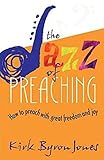As an Amazon Associate I earn from qualifying purchases.
 Kirk Byron Jones introduces the concept of “playing words” in his helpful book The Jazz of Preaching. As I thought about that and unified it with my early forays into attempting to play Jazz on the Trumpet, I recognized that playing a note has many dimensions. I will do my best not to use music terminology. The first of these is volume.
Kirk Byron Jones introduces the concept of “playing words” in his helpful book The Jazz of Preaching. As I thought about that and unified it with my early forays into attempting to play Jazz on the Trumpet, I recognized that playing a note has many dimensions. I will do my best not to use music terminology. The first of these is volume.
Volume
I was talking to Martha Simmons in between one of her lectures and she emphasized to me that one of the biggest problems that Black preachers have is too much volume. We don’t recognize that lowering the volume of the voice can be just as effective as raising the volume.
I know this in my head, but my heart still has a way to go. I find myself raising my voice to the point of not being able to continue a crescendo. However, when I played the trumpet, the music called for lowering and raising the volume of the notes played.
If I am to be a more effective communicator then I must “play” the words. I must raise and lower the volume of the words that are played. Loud volume is needed at times, but it is not the only way to emphasize. I have been working on this for a while and hope to continue working to get better.
Note Length
In Music there are notes that take 4 beats, 2 beats, a half beat, 1/4 beat, and even smaller and longer. When we “play” words we also change the number of beats for each word. Some words take longer to “play” just by virtue of them being longer.
However, the composer will change the note length for effect. If I am to “play words,” I must play around with the length of the note. How long to I hold the word. Do I hold the “important” words longer so that they can stay there and have the intended effect? Do I hold the wrong words? These are some questions that we should ask to improve our “Playing” of words.
Rest
There are places in the music that you are not playing. You are not always filling up the song with music. The silence is a part of the music. So it is with preaching. I have heard some preachers who are always playing words, but never give us time to process the words.
Perfect times for rest are when you want the people to contemplate the word you just played or the concept it described. I often want to fill every moment with words, but when I do rest at the appropriate time, I find that the sermon is much more effective. Another thing that rest does is allow for the Holy Spirit to come in and say something.
Color of the Note and Rhythm?
There is the color of the note. Here is whether the note is played in a staccato or a legato? Is it choppy or smooth? Is it played with a mute or a open bell? Some even play the trumpet with a flutter tongue at times.
In preaching we sometimes use a choppy delivery style and a smooth one depending on the demands of the sermon. This also gets into the rhythm of the presentation. Do you always use the same color or rhythm? I find that I automatically change both based on what i am saying, but attention to this might help me to be a more effective preacher.
Tone of the Note
Finally, there is the tone of the note. Do you always preach the same tone? If someone transcribed your voice musically would you find that it would be the same tone the whole time? Maybe a Eb over and over and over again. Music requires a change in tone, perhaps preaching should as well.
Conclusion
This is experimental. I have no real conclusions just things to try and play with. How do you improve your preaching style? Maybe attention to these aspects of music that I learned from playing the trumpet can help us “play words” more effectively.
Amazon and the Amazon logo are trademarks of Amazon.com, Inc, or its affiliates.


